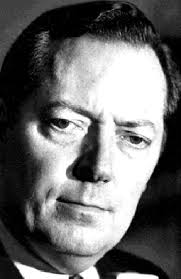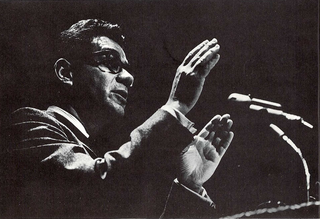Related Research Articles

Jack Leon Ruby was an American nightclub owner who killed Lee Harvey Oswald on November 24, 1963, two days after Oswald was accused of assassinating President John F. Kennedy. Ruby shot and mortally wounded Oswald on live television in the basement of Dallas Police Headquarters and was immediately arrested.

Lee Harvey Oswald was a U.S. Marine veteran who assassinated John F. Kennedy, the 35th president of the United States, on November 22, 1963.

The President's Commission on the Assassination of President Kennedy, known unofficially as the Warren Commission, was established by President Lyndon B. Johnson through Executive Order 11130 on November 29, 1963, to investigate the assassination of United States President John F. Kennedy that had taken place on November 22, 1963.

James Carothers Garrison was the District Attorney of Orleans Parish, Louisiana, from 1962 to 1973 and later a state appellate court judge. A member of the Democratic Party, he is best known for his investigations into the assassination of John F. Kennedy and the prosecution of New Orleans businessman Clay Shaw to that effect in 1969, which ended in Shaw's acquittal. He wrote three published books, one of which became a prime source for Oliver Stone's film JFK in 1991, in which Garrison was portrayed by Kevin Costner, while Garrison himself made a cameo appearance as Earl Warren.

John F. Kennedy, the 35th president of the United States, was assassinated while riding in a presidential motorcade through Dealey Plaza in Dallas, Texas, on November 22, 1963. Kennedy was in the vehicle with his wife Jacqueline, Texas governor John Connally, and Connally's wife Nellie, when he was fatally shot from the nearby Texas School Book Depository by Lee Harvey Oswald, a former U.S. Marine. The motorcade rushed to Parkland Memorial Hospital, where Kennedy was pronounced dead about 30 minutes after the shooting; Connally was also wounded in the attack but recovered. Vice President Lyndon B. Johnson was hastily sworn in as president two hours and eight minutes later aboard Air Force One at Dallas Love Field.

Vincent T. Bugliosi Jr. was an American prosecutor and author who served as Deputy District Attorney for the Los Angeles County District Attorney's Office between 1964 and 1972. He became best known for successfully prosecuting Charles Manson and other defendants accused of the Tate–LaBianca murders that took place between August 9 and August 10, 1969.

J. D. Tippit was an American World War II U.S. Army veteran and Bronze Star recipient, who was a police officer with the Dallas Police Department for 11 years. About 45 minutes after the assassination of John F. Kennedy on November 22, 1963, Tippit was shot and killed in a residential neighborhood in the Oak Cliff section of Dallas, Texas, by Lee Harvey Oswald. Oswald was initially arrested for the murder of Tippit and was subsequently charged with killing President Kennedy. Oswald was murdered by Jack Ruby, a Dallas nightclub owner, two days later.

Henry Menasco Wade was an American lawyer who served as district attorney of Dallas County from 1951 to 1987. He participated in two notable U.S. court cases of the 20th century: the prosecution of Jack Ruby for killing Lee Harvey Oswald, and the U.S. Supreme Court case that held abortion was a constitutional right, Roe v. Wade. In addition, Wade was district attorney when Randall Dale Adams, the subject of the 1988 documentary film The Thin Blue Line, was wrongfully convicted in the murder of Robert Wood, a Dallas police officer. After his term and death, he was criticised for his corruption, ranging from wrongful convictions, to altitudes and certain comments on race, in addition to some decisions such as execution of innocent men.

Marina Nikolayevna Oswald Porter is a Russian–American former pharmacist who was the wife of Lee Harvey Oswald.

This article outlines the timeline of events before, during, and after the assassination of John F. Kennedy, the 35th president of the United States.

Charles Voyde Harrelson was an American contract killer and organized crime figure who was convicted of assassinating federal judge John H. Wood Jr., the first federal judge to be assassinated in the 20th century. Charles Harrelson was the father of actors Brett and Woody Harrelson.

Mark Lane was an American attorney, New York state legislator, civil rights activist, and Vietnam war-crimes investigator. Sometimes referred to as a gadfly, Lane is best known as a leading researcher, author, and conspiracy theorist on the assassination of United States President John F. Kennedy. Lane authored many books, including 10 on the JFK assassination, such as Rush to Judgment,, the 1966 number-one bestselling critique of the Warren Commission and Last Word: My Indictment of the CIA in the Murder of JFK, published in 2011.

Under Age is a 1964 black-and-white film written and directed by Larry Buchanan and starring Annabelle Weenick, Judy Adler and Roland Royter. The film was shot in Dallas, Texas.

Robert J. Groden is an American author who has written extensively about conspiracy theories regarding the assassination of U.S. President John F. Kennedy. His books include The Killing of a President: The Complete Photographic Record of the JFK Assassination, the Conspiracy, and the Cover-up; The Search for Lee Harvey Oswald: A Comprehensive Photographic Record; and JFK: The Case for Conspiracy. Groden is a photo-optics technician who served as a photographic consultant for the House Select Committee on Assassinations.

On March 1, 1967, New Orleans District attorney Jim Garrison arrested and charged New Orleans businessman Clay Shaw with conspiring to assassinate President Kennedy, with the help of Lee Harvey Oswald, David Ferrie, and others. On January 29, 1969, Shaw was brought to trial in Orleans Parish Criminal Court on these charges. On March 1, 1969, a jury took less than an hour to find Shaw not guilty. It remains the only trial to be brought for the assassination of President Kennedy.
The assassination of John F. Kennedy and the subsequent conspiracy theories surrounding it have been discussed, referenced, or recreated in popular culture numerous times.

Reclaiming History: The Assassination of President John F. Kennedy is a book by attorney Vincent Bugliosi that analyzes the events surrounding the assassination of United States President John F. Kennedy, focusing on the lives of Lee Harvey Oswald and Jack Ruby. He drew from many sources, including the Warren Report. Bugliosi argues that the Warren Commission's conclusion that Lee Oswald acted alone in shooting Kennedy is correct. The book won the 2008 Edgar Award for the Best Fact Crime category. Bugliosi explored the issues at length; the book is 1,632 pages. It was published with an accompanying CD-ROM containing an additional 1,000+ pages of footnotes. He analyzed both the assassination itself and the rise of the conspiracy theories about the event in the following years.

The Trial of Lee Harvey Oswald is an American two-part television film shown on ABC in September 1977. The film stars Ben Gazzara, Lorne Greene and John Pleshette in the title role. It is an example of alternative history. The hypothesis is what might have happened if Lee Harvey Oswald had not been killed by Jack Ruby and had stood trial for the murder of President John F. Kennedy.
The CIA Kennedy assassination is a prominent John F. Kennedy assassination conspiracy theory. According to ABC News, the Central Intelligence Agency (CIA) is represented in nearly every theory that involves American conspirators. The secretive nature of the CIA, and the conjecture surrounding the high-profile political assassinations in the United States during the 1960s, has made the CIA a plausible suspect for some who believe in a conspiracy. Conspiracy theorists have ascribed various motives for CIA involvement in the assassination of President Kennedy, including Kennedy's firing of CIA director Allen Dulles, Kennedy's refusal to provide air support to the Bay of Pigs invasion, Kennedy's plan to cut the agency's budget by 20 percent, and the belief that the president was weak on communism. In 1979, the House Select Committee on Assassinations (HSCA) concluded that the CIA was not involved in the assassination of Kennedy.

The assassination of John F. Kennedy on November 22, 1963, has spawned numerous conspiracy theories. These theories allege the involvement of the CIA, the Mafia, Vice President Lyndon B. Johnson, Cuban Prime Minister Fidel Castro, the KGB, or some combination of these individuals and entities. Some conspiracy theories have alleged a coverup by parts of the federal government, such as the original FBI investigators, the Warren Commission, or the CIA. Lawyer and author Vincent Bugliosi estimated that a total of 42 groups, 82 assassins, and 214 people had been accused at one time or another in various conspiracy scenarios.
References
- ↑ Craig, Rob (2007). The Films of Larry Buchanan: A Critical Examination. McFarland & Company. pp. 67–75. ISBN 978-0786429820.
- ↑ The Trial of Lee Harvey Oswald at The New York Times .